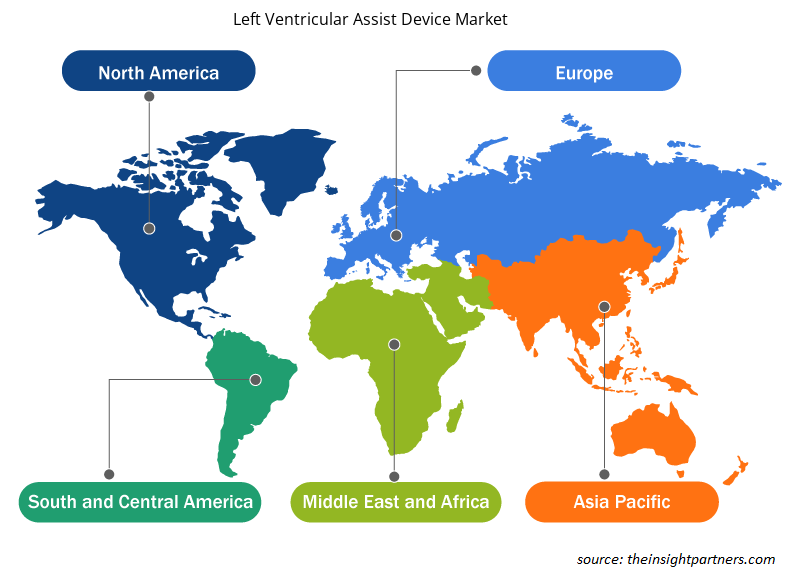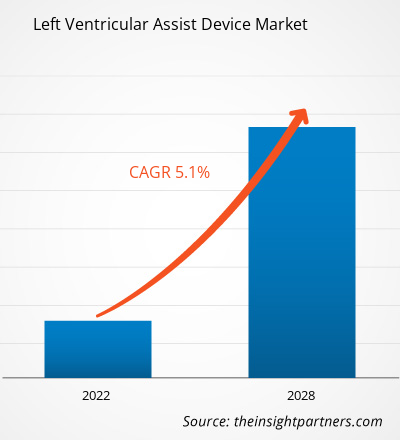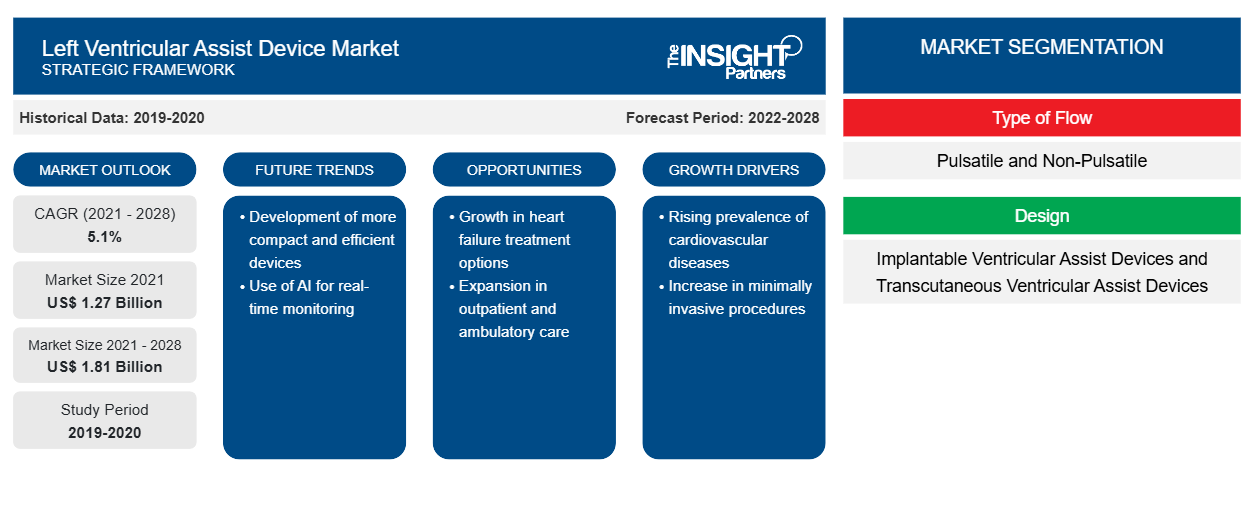[Forschungsbericht] Der Markt für Linksherzunterstützungssysteme sollte im Jahr 2021 voraussichtlich 1.272,08 Millionen US-Dollar erreichen und von 2022 bis 2028 mit einer durchschnittlichen jährlichen Wachstumsrate von 5,1 % wachsen.
Das Linksherzunterstützungssystem unterstützt die linke Herzkammer dabei, Blut in den Rest des Körpers zu pumpen. Es ist auch als mechanisches Kreislaufunterstützungsgerät bekannt, das dabei hilft, die richtige Blutzirkulation im Körper aufrechtzuerhalten. Die zunehmende Verbreitung von Herz-Kreislauf-Erkrankungen und Herzinsuffizienz sowie ein deutlicher Anstieg der geriatrischen und fettleibigen Bevölkerung treiben das Wachstum des Marktes für Linksherzunterstützungssysteme voran . Allerdings hemmen zunehmende Produktrückrufe und Komplikationen im Zusammenhang mit Linksherzunterstützungssystemen das Marktwachstum.
Der Bericht bietet Einblicke und eine eingehende Analyse des Marktes für Linksherzunterstützungssysteme und hebt dabei verschiedene Parameter wie Markttrends, technologische Fortschritte, Marktdynamik und Wettbewerbslandschaftsanalysen der weltweit führenden Marktteilnehmer hervor. Er umfasst auch die Auswirkungen der COVID-19-Pandemie auf den Markt in allen Regionen. Aufgrund der COVID-19-Pandemie konzentrierten sich viele Gesundheitsbehörden auf die pandemiebedingte Versorgung. Sie vermieden menschlichen Kontakt aufgrund der zunehmenden Übertragung und der Belastung der Gesundheitsressourcen, indem sie elektive Operationen verschoben, ambulante Kliniken schlossen und Mitarbeiter in der Notfallversorgung nach Triage sortierten . Darüber hinaus verhängten viele Länder Beschränkungen für den Zugang von nicht-klinischem Personal zu den Einrichtungen und für Gäste. Darüber hinaus gab es einen Anstieg der Prävalenz von Herz-Kreislauf-Erkrankungen bei COVID-19-Patienten, was die Nachfrage nach Linksherzunterstützungssystemen weiter steigerte, was zu einem Marktwachstum führte. Jüngste COVID-19-Richtlinien für medizinisches Fachpersonal schlugen vor, sich auf die Notfallversorgung und Triage von Fällen zu konzentrieren, um elektive Operationen und Kliniktermine zu verschieben und bei Bedarf auf virtuelle Versorgung umzusteigen.
Passen Sie diesen Bericht Ihren Anforderungen an
Sie erhalten kostenlose Anpassungen an jedem Bericht, einschließlich Teilen dieses Berichts oder einer Analyse auf Länderebene, eines Excel-Datenpakets sowie tolle Angebote und Rabatte für Start-ups und Universitäten.
-
Holen Sie sich die wichtigsten Markttrends aus diesem Bericht.Dieses KOSTENLOSE Beispiel umfasst eine Datenanalyse von Markttrends bis hin zu Schätzungen und Prognosen.
Darüber hinaus reagieren Hersteller vieler Linksherzunterstützungssysteme auf Notfälle mit verschiedenen Strategien, beispielsweise der Herstellung von PSA für medizinisches Personal, der Verteilung von Arzneimitteln und anderen Aktivitäten. Darüber hinaus haben Medtronic und die Medtronic Foundation im November 2020 eine weltweite finanzielle Unterstützung von 3,8 Millionen US-Dollar zugesagt, um medizinisches Personal in Form von Nahrungsmitteln, operativer Unterstützung, psychischer Unterstützung, PSA- Kits und mehr zu unterstützen. Somit hatte die Pandemie kurzfristig negative Auswirkungen auf den Markt für Linksherzunterstützungssysteme.
Der Markt für Linksherzunterstützungssysteme ist nach Strömungsart, Design, Anwendung und Geografie segmentiert. Nach Regionen ist der Markt in Nordamerika, Europa, Asien-Pazifik, den Nahen Osten und Afrika sowie Süd- und Mittelamerika unterteilt.
Markteinblicke
Zunehmende Häufigkeit von Zielkrankheiten und -verfahren
Laut der Weltgesundheitsorganisation (WHO) sind Herz-Kreislauf-Erkrankungen ( CVD ) eine der häufigsten Todesursachen weltweit. Einige Hauptfaktoren, die die Prävalenz von CVD und Schlaganfällen erhöhen, sind Familiengeschichte, ethnische Zugehörigkeit und Alter. Die Prävalenz von CVD steigt auch aufgrund von Tabakkonsum, Bluthochdruck (Hypertonie), hohem Cholesterinspiegel, Bewegungsmangel, ungesunder Ernährung, übermäßigem Alkoholkonsum sowie Krankheiten wie Dyslipidämie , Fettleibigkeit und Diabetes. Laut der American Heart Association werden bis 2030 etwa 41,4 % der Erwachsenen in den USA an Bluthochdruck leiden (ein Anstieg von 8,4 % seit 2012). Die Organisation schätzt außerdem, dass die globale Kostenbelastung durch Herz-Kreislauf-Erkrankungen bis 2030 1.044 Milliarden US-Dollar erreichen wird, im Jahr 2010 waren es noch 863 Milliarden US-Dollar. Darüber hinaus werden die Todesfälle aufgrund von Herz-Kreislauf-Erkrankungen laut WHO -Schätzungen weltweit von ~17,9 Millionen im Jahr 2016 auf 23,6 Millionen bis 2030 steigen. Laut dem Bericht von Emory Healthcare wurden in den USA im Jahr 2022 ~5 Millionen Fälle von Herzinsuffizienz registriert und jedes Jahr wurden im Land ~550.000 neue Fälle diagnostiziert. Außerdem werden jedes Jahr ~287.000 Todesfälle aufgrund von Herzinsuffizienz gemeldet.
Laut Temple Health erhielten 70,9 % der Patienten innerhalb eines Jahres eine Herztransplantation , und die kürzeste Warteliste betrug 2021 in den USA durchschnittlich 55,2 %. Die weltweit zunehmende Warteliste für Herztransplantationen hat den Einsatz von Linksherzunterstützungssystemen ( LVADs ) bei Patienten mit Herzinsuffizienz im Endstadium vorangetrieben, um die Auswurffraktion zu erhöhen und Organversagen vorzubeugen. Daher treiben die steigende Prävalenz von CVD und Herzinsuffizienz sowie die lange Warteliste für eine Herztransplantation die Einführung von LVADs voran , was das Wachstum des Marktes für Linksherzunterstützungssysteme vorantreibt.
Art der flussbasierten Erkenntnisse
Basierend auf der Art des Flusses ist der globale Markt für Linksherzunterstützungssysteme in pulsierende und nicht pulsierende unterteilt . Im Jahr 2021 hatte das nicht pulsierende Segment einen größeren Marktanteil und es wird erwartet, dass es im Zeitraum 2022–2028 eine höhere CAGR auf dem Markt verzeichnen wird.
Designbasierte Erkenntnisse
Basierend auf dem Design ist der Markt für Linksherzunterstützungssysteme in implantierbare Herzunterstützungssysteme und transkutane Herzunterstützungssysteme unterteilt. Das Segment der implantierbaren Herzunterstützungssysteme hatte 2021 einen größeren Marktanteil und wird im Prognosezeitraum voraussichtlich eine höhere CAGR verzeichnen.
Anwendungsbasierte Erkenntnisse
Basierend auf der Anwendung ist der Markt für Linksherzunterstützungssysteme in Zieltherapie, Überbrückung bis zur Transplantation, Überbrückung bis zur Kandidatur und Überbrückung bis zur Genesung segmentiert. Das Segment Zieltherapie hatte 2021 den größten Marktanteil und wird im Prognosezeitraum voraussichtlich die höchste durchschnittliche jährliche Wachstumsrate verzeichnen.
Die Akteure auf dem Markt für Linksherzunterstützungssysteme verfolgen organische Strategien wie Produkteinführungen, Produktzulassungen und Expansion, um ihre Präsenz und ihr Produktportfolio weltweit zu erweitern und der wachsenden Nachfrage gerecht zu werden. Im Juni 2020 gab Abiomed bekannt, dass die US-amerikanische Food and Drug Administration (FDA) seinen Antrag auf Ausnahmegenehmigung für Prüfpräparate genehmigt hat, um eine frühe Machbarkeitsstudie mit einer ersten Studie am Menschen für die Impella ECP-Herzpumpe zu starten.
Geographiebasierte Erkenntnisse
Geografisch ist der Markt für Linksherzunterstützungssysteme in Nordamerika (USA, Kanada und Mexiko), Europa (Frankreich, Deutschland, Großbritannien, Spanien, Italien und das übrige Europa), den asiatisch-pazifischen Raum (China, Indien, Japan, Australien, Südkorea und den Rest des asiatisch-pazifischen Raums), den Nahen Osten und Afrika (Saudi-Arabien, die Vereinigten Arabischen Emirate, Südafrika und den Rest des Nahen Ostens) sowie Süd- und Mittelamerika (Brasilien, Argentinien und den Rest Süd- und Mittelamerikas) unterteilt.
Regionale Einblicke in den Markt für Linksherzunterstützungssysteme
Die regionalen Trends und Faktoren, die den Markt für Linksherzunterstützungssysteme im Prognosezeitraum beeinflussen, wurden von den Analysten von Insight Partners ausführlich erläutert. In diesem Abschnitt werden auch die Marktsegmente und die Geografie für Linksherzunterstützungssysteme in Nordamerika, Europa, im asiatisch-pazifischen Raum, im Nahen Osten und Afrika sowie in Süd- und Mittelamerika erörtert.

- Erhalten Sie regionale Daten zum Markt für Linksherzunterstützungssysteme
Umfang des Marktberichts zum Linksherzunterstützungssystem
| Berichtsattribut | Details |
|---|---|
| Marktgröße im Jahr 2021 | 1,27 Milliarden US-Dollar |
| Marktgröße bis 2028 | 1,81 Milliarden US-Dollar |
| Globale CAGR (2021 - 2028) | 5,1 % |
| Historische Daten | 2019-2020 |
| Prognosezeitraum | 2022–2028 |
| Abgedeckte Segmente |
Nach Flusstyp
|
| Abgedeckte Regionen und Länder |
Nordamerika
|
| Marktführer und wichtige Unternehmensprofile |
|
Marktteilnehmerdichte für Linksherzunterstützungssysteme: Auswirkungen auf die Geschäftsdynamik verstehen
Der Markt für Linksherzunterstützungssysteme wächst rasant. Dies wird durch die steigende Nachfrage der Endnutzer aufgrund von Faktoren wie sich entwickelnden Verbraucherpräferenzen, technologischen Fortschritten und einem größeren Bewusstsein für die Vorteile des Produkts vorangetrieben. Mit der steigenden Nachfrage erweitern Unternehmen ihr Angebot, entwickeln Innovationen, um die Bedürfnisse der Verbraucher zu erfüllen, und nutzen neue Trends, was das Marktwachstum weiter ankurbelt.
Die Marktteilnehmerdichte bezieht sich auf die Verteilung der Firmen oder Unternehmen, die in einem bestimmten Markt oder einer bestimmten Branche tätig sind. Sie gibt an, wie viele Wettbewerber (Marktteilnehmer) in einem bestimmten Marktraum im Verhältnis zu seiner Größe oder seinem gesamten Marktwert präsent sind.
Die wichtigsten Unternehmen auf dem Markt für Linksherzunterstützungssysteme sind:
- ABIOMED Inc
- Abbott Laboratories
- Medtronic Plc
- LivaNova Plc
- Jarvik Heart Inc
Haftungsausschluss : Die oben aufgeführten Unternehmen sind nicht in einer bestimmten Reihenfolge aufgeführt.

- Überblick über die wichtigsten Akteure auf dem Markt für Linksherzunterstützungssysteme
Unternehmensbasierte Einblicke
Zu den führenden Unternehmen auf dem Markt für Linksherzunterstützungssysteme gehören ABIOMED Inc, Abbott Laboratories, Medtronic Plc, LivaNova Plc, Jarvik Heart Inc, Terumo Corp, Berlin Heart GmbH, BiVACOR Inc, Evaheart Inc und BioVentrix Inc.Medtronic Plc, LivaNova Plc, Jarvik Heart Inc, Terumo Corp, Berlin Heart GmbH, BiVACOR Inc, Evaheart Inc, and BioVentrix Inc. are among the leading companies operating in the left ventricular assist device market.
- Historische Analyse (2 Jahre), Basisjahr, Prognose (7 Jahre) mit CAGR
- PEST- und SWOT-Analyse
- Marktgröße Wert/Volumen – Global, Regional, Land
- Branchen- und Wettbewerbslandschaft
- Excel-Datensatz
Aktuelle Berichte
Erfahrungsberichte
Grund zum Kauf
- Fundierte Entscheidungsfindung
- Marktdynamik verstehen
- Wettbewerbsanalyse
- Kundeneinblicke
- Marktprognosen
- Risikominimierung
- Strategische Planung
- Investitionsbegründung
- Identifizierung neuer Märkte
- Verbesserung von Marketingstrategien
- Steigerung der Betriebseffizienz
- Anpassung an regulatorische Trends























 Kostenlose Probe anfordern für - Markt für linksventrikuläre Unterstützungssysteme
Kostenlose Probe anfordern für - Markt für linksventrikuläre Unterstützungssysteme